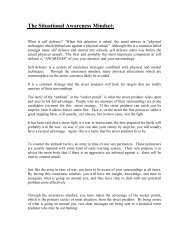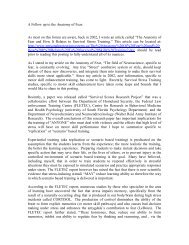Threat Pattern Recognition - Personal Protection Systems Inc
Threat Pattern Recognition - Personal Protection Systems Inc
Threat Pattern Recognition - Personal Protection Systems Inc
Create successful ePaper yourself
Turn your PDF publications into a flip-book with our unique Google optimized e-Paper software.
<strong>Threat</strong> <strong>Pattern</strong> <strong>Recognition</strong> and Early <strong>Threat</strong> <strong>Recognition</strong> Skills<br />
“Reading Behavioral Intent”<br />
No matter the mode of attack (psychological, emotional, verbal, physical), or if the threat<br />
is armed or not, what can give us the tactical advantage, especially in the pre-contact<br />
phase of a confrontation, is the ability to recognize a threat pattern. Because we know<br />
that the skilled predator(s) will use the element of surprise to their advantage, there are<br />
threat patterns that we should all be aware of that can alert us to a potential attack, thus<br />
minimizing the threats primary advantage, that being the element of surprise.<br />
Before I share some of the <strong>Pattern</strong>s and <strong>Threat</strong> <strong>Recognition</strong>s to be aware of, I believe it is<br />
important that the reader review my article on the Anatomy of Fear that can be located at:<br />
http://www.personalprotectionsystems.ca/The%20Anatomy%20Of%20Fear%20and%20<br />
How%20It%20Relates%20To%20Survival%20Skills%20Training2.doc<br />
In this article I shared the following:<br />
1. The brain has been hard-wired to deal with the emotion of fear/violence<br />
2. One pathway is known as the high road in which action can be based on<br />
conscious will and thought. This pathway appears to take effect during<br />
progressive types of fear stimuli. Here a combatives student will be able to<br />
apply stimulus/response type training using the OODA model having regards to<br />
gross motor skills and Hicks Law<br />
3. A second pathway is known as the low road which is triggered by a<br />
spontaneous/ unexpected attack. Here, the brain will take control of the body<br />
with an immediate protective reflex (downloaded directly to the brain stem<br />
where all of our reflexive responses to danger are stored), which will override any<br />
system of combat that bases its ability on cognitively applying a physical<br />
response. This is especially true if the trained response is not congruent with the<br />
protective reflex (this is exactly what I observed in the 1992 video study that I<br />
conducted and mentioned earlier in this article)<br />
When it comes to <strong>Threat</strong> <strong>Pattern</strong> <strong>Recognition</strong>, it is important to note that there are two<br />
different threat patterns to be aware of that are, in my opinion, very closely related to the<br />
high road and low road fear response that I have called:<br />
1. High emotional arousal patterns (low road), and<br />
2. Low emotional arousal patterns (high road)
In my article Ritualized Combat located at:<br />
http://www.personalprotectionsystems.ca/Ritualized%20Combat.doc<br />
I discussed ritualized combative signs that fell under three specific categories:<br />
1. Assault Not Imminent But Possible<br />
2. Assault is Imminent<br />
3. Signs of submission<br />
It has been my experience, that many of the ritualized combative signs that fall under<br />
these three categories (especially the first two), are very much associated with high<br />
emotional arousal patterns. One only has to review the hours and hours of CCTV<br />
videotape of violent encounters on the Internet, to observe these ritualized combative<br />
signs in action. Often these signs are visible in the inexperienced attacker, or what I<br />
like to call the baby predator, or by those who resort to violence, usually based upon ego,<br />
and often fueled by alcohol and/or drugs. This form of violence often takes place without<br />
cognitive rationale, and can often be seen in the form of a rage attack. These guys, once<br />
you understand these high emotional arousals, are often very easy to read in the precontact<br />
phase of a physical encounter.<br />
Having shared the above, it has also been my experience, that many of these ritualized<br />
combative signs that can be seen in the high emotional arousal patterns, can often be<br />
cloaked by the experienced covert attacker, who truly understands the tactical<br />
advantage of the surprise ambush, thus making their intended target extremely vulnerable<br />
to a committed attack. By being aware of the low emotional arousal patterns of these<br />
experienced attackers, we can again provide ourselves with cognitive red flags that can<br />
turn a surprise ambush, that works to the advantage of the attacker, into a prepared<br />
interdiction via awareness, avoidance/disengagement, non-verbal or verbal<br />
communication, or even a committed physical attack using the element of surprise on our<br />
part. So what are some of the low emotional arousal patterns that I have observed being<br />
used by the experienced covert attacker:<br />
A) Stalking behaviour, not unlike what we see in the animal kingdom when a snake<br />
approaches its prey
B) Positioning:<br />
The professional will usually use one of four relative positioning tactics to set their<br />
intended victim up for attack:<br />
1) Closing:<br />
- Most common, walks directly up to target to get as close as they can<br />
- The closer they get the more success he will have in his abilities to overwhelm<br />
and control<br />
2) Cornering/ Trapping:<br />
- This is the second most commonly used tactic<br />
- Will want to corner you between himself, you, and any safe exit point<br />
3) Pincer:<br />
- Usually used by two or more criminals<br />
- One circles while the other distracts you<br />
- One attacker follows from behind and while you are focused on them, there is a<br />
second attacker just up ahead<br />
- Things to be aware of, two people standing across from one another in a narrow<br />
space such as a hallway, staircase, or alley<br />
4) Surround:<br />
- Most common in packs or swarms<br />
- One in the pack will distract while the others surround<br />
- Instead of a fast swarm, the pack will usually drift towards you so as not to alert<br />
you to their intentions<br />
c) The Chameleon Effect:<br />
The professional will often wear clothing and items that help:<br />
• Conceal Weapons (both overt and covert), or make the access to a weapon easier<br />
during the acquisition phase<br />
• Conceal the signs of ritualized combat, such as sunglasses (even when it is dark<br />
outside or even when inside a building) or hats
d) The Tell:<br />
A fellow police officer that I know in Ontario, was able to identify a subject who was<br />
carrying a concealed illegal firearm in a shoulder holster under his jacket, by the way he<br />
was periodically (and likely unconsciously) moving the arm in which the firearm was<br />
hanging under. My friend was able to notice this because he did the same thing when he<br />
carried. This in my opinion is a really good example of low emotional threat pattern<br />
recognition. Some other tells could include:<br />
• How is the person carrying a visible weapon such as a knife. Is it a clip-it type<br />
knife that blends in color to the garment being worn by the potential threat? Is it a<br />
knife (such as a Buck knife) that is kept in a pouch, but the pouch is carried<br />
upside down to allow the force of gravity to deploy the knife into the hand<br />
quickly, once unsnapped, with very little arm movement; a favorite of some<br />
outlaw motor cycle gangs.<br />
• Is the movement of a persons body (especially hands and arms), consistent with<br />
the pre-deployment of a weapon, be it concealed or visible?<br />
While working narcotics enforcement (especially form covert observation posts), I would<br />
often use pattern recognition tells that were consistent with those who were dealing at<br />
the street level; such as head and eye movement, positioning to sell their product, the<br />
short walk and talks, which would allow me to concentrate my observations on primary<br />
targets to watch more closely.<br />
The two goals of this article were:<br />
1) To once again bring to light the high emotional patterns of ritualized<br />
combat that are often very visible overt precursors to a physical attack,<br />
and<br />
2) To become more aware of the low emotional/behavioral patterns of the<br />
experienced attacker, who uses the element of the surprise ambush to their<br />
tactical advantage for a committed covert attack.<br />
<strong>Threat</strong> pattern recognition, and early threat recognition skills, during the awareness<br />
phase, are the first steps in staying safe, and can play a very important role in reading<br />
behavioral intent. This process can then allow one to utlize avoidance/escape/evasion<br />
strategies, or to engage a threat either non-verbally, verbally, and/or physically (including
the pre-deployment of a weapon on your part) prior to an actual physical attack by the<br />
threat faced.<br />
Darren





